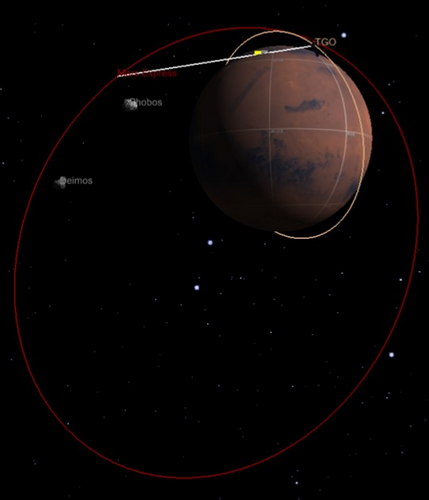First results from the MEX – TGO Mutual Radio Occultation Experiment
- 1ESA/ESTEC, Space Science Department, Noordwijk, Netherlands (h.svedhem@esa.int)
- 2ESA/ESAC, Villafrance del Castillo, Madrid, Spain
- 3ESA/ESOC, Darmstadt, Germany
- 4ICTP, Trieste, Italy
Conventional Radio Occultation measurements take place between a spacecraft in orbit around a planet (or during an occasional fly-by), and a receiving ground station on the Earth. When the straight line between the sender and receiver crosses the ionosphere and the atmosphere of the planet the signal is affected by the electrons in the ionosphere and the molecules in the neutral atmosphere. This signal change is observed as a slight frequency shift in the received radio signal with respect to the transmitted signal. The shift is very small compared to the Doppler shift in the frequency due to the differential relative velocity of the spacecraft and the Earth, but can for a stable system be isolated, and profiles of electron density in the ionosphere and profiles of atmospheric density in the neutral atmosphere can be derived.
Here we are attempting to do occultation measurements between two spacecraft at Mars, Mars Express and ExoMars Trace Gas Orbiter, using the UHF link normally used for communicating between the orbiters and the landers on the surface of Mars, rather than using the X- or S-band transmitter used for the communication between a spacecraft and the Earth. This was first exercised between NASA’s Odyssey and MRO at three occasions in 2007 (Ao, et al., Radio Sci., 2015), but has not been repeated since then.
Such a Mutual Occultation technique has several significant advantages over the traditional spacecraft to Earth occultation measurements. In particular, it allows a much more even distribution of the samples over the surface of the planet and in time, and the observations are independent of Earth occultation seasons. Due to the short period of the orbit of TGO many occultations take place every day. The distance between the two spacecraft is much smaller than the distance to the Earth and therefore a much higher signal to noise ratio can be achieved, resulting in very low statistical errors. The Mutual Occultation s/c to s/c link also avoids that the signal passes through the Earth’s ionosphere and atmosphere. The compensation for the Earth atmosphere and ionosphere is far from perfect and results in major contributions to the systematic errors. An additional positive effect is that the interplanetary plasma disturbance to the signal is a minimum due to the short distance between the two s/c and the large distance from the Sun.
The first experiment was carried out on the 2nd of November 2020 and demonstrated the feasibility of the technique. Several more experiments took place during November-December. These initial test used a lander (Beagle2) hail signal from Mars Express/Melacom, consisting of a series of 20 seconds of modulated and unmodulated transmissions interspersed with 2 seconds without transmission. In March 2021 a software update was applied to Melacom, which allowed it to generate an uninterrupted, unmodulated carrier-only signal, since. This has improved the performance and the quality of the measurements significantly. To date four passes with this improved performance have been executed. These data are presently being analysed. This presentation will summarise recent simulations and show the latest results from these new experimental measurements.

Example of Occultation Geometry: The orbits of TGO and MEX are indicated by tan respective red lines and the direct path of the radio signal is indicated by a white line. The part of the propagation through the atmosphere is indicated by a yellow box.
How to cite: Svedhem, H., Parrott, J., Witasse, O., Titov, D., Cardesin, A., Geiger, B., Martin, P., Denis, M., Godfrey, J., Schmitz, P., Wood, S., Reboud, O., and Nava, B.: First results from the MEX – TGO Mutual Radio Occultation Experiment, European Planetary Science Congress 2021, online, 13–24 Sep 2021, EPSC2021-719, https://doi.org/10.5194/epsc2021-719, 2021.

